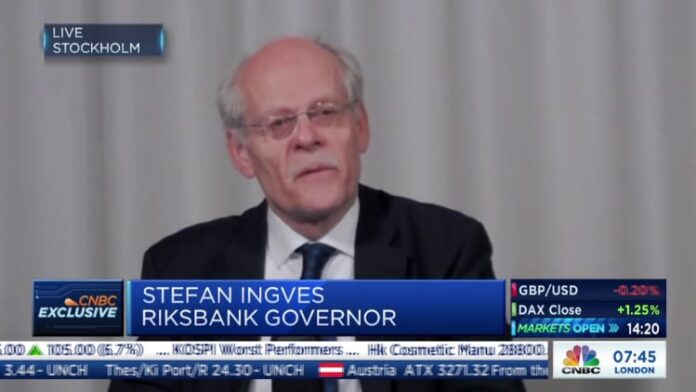The people of Sweden are feeling the effects of high inflation and falling house prices.
JONATHAN NACKSTRAND/Staff/Getty Images
The Swedish government is now forecasting a stronger-than-expected fall in GDP in 2023, according to data released on Monday, worsening an already bleak outlook for the country’s economy.
Sweden’s Treasury Ministry estimated in December that GDP would contract by 0.7%, but it is now forecasting a 1% contraction as it reassesses the “challenging economic environment”.
“We are facing major challenges, but we will overcome them together,” Sweden’s Finance Minister Elisabeth Svantesson said in a press release on Monday.
“Many people are struggling to make ends meet, so it is important that the government fight inflation and support those in the most difficult circumstances.”
Sweden’s government had already described the country’s economic prospects for 2023 as “bleak” in a report in October 2022, with expectations that the economy would slide into recession. The latest CPI data shows inflation is finally slowing, but wages are lagging and house prices are poised for a serious drop.
The European Commission, the EU’s executive arm, repeated the dovish tone in its latest growth outlook, where Sweden is the only country where GDP growth is expected to slip into negative territory this year.
The Commission forecast a fall of 0.8% in 2023 and a rise of 1.2% in 2024, the second lowest estimate after Italy. So where is the economy weakening?
High inflation rates
Sweden’s inflation rate is starting to cool, according to core CPI data released on Friday, with the key rate for March falling to 8% from 9.4% in the previous month, but the figure remains well above the central bank’s target rate of 2%.
While March CPI data is a sign that inflation is moving in the right direction, Swedish households are unlikely to get much reprieve from the numbers.
“People have less purchasing power than they have had for a number of years… So many people are struggling with basic things and are also cutting back on their consumption,” said Ola Olsson, professor of economics and vice-dean at the School of Business, Economics and Law at the University of Gothenburg CNBC before the inflation figures were released.
The National Institute of Economic Research said last month that it expects inflation — excluding energy — to remain elevated throughout the year, and it will take until the second quarter of 2024 before it finally falls below 2%.
The Swedish think tank also warned that it would take until 2025 for the economy to pick up significantly again and that an expected recession would not end until 2026.
Homeowners’ spending has risen sharply since 2020, according to Zmarta’s Homeowners Index. Housing costs, which include costs for the house and its properties such as electricity and water, taxes and interest costs, currently amount to 206,039 Swedish kronor (US$20,000) per year, compared to 116,483 per year as calculated in the first half of 2020.
According to Swedbank, the inflation number should also have no impact on the central bank’s rate-hiking cycle, which unexpectedly started in April last year.
“We take care of it afterwards [Friday’s] Data that the Riksbank will hike 50 basis points [on April 26]’ the bank said in a statement.
eroding real wages
Most European countries are experiencing sky-high inflation, causing real wages to lag. In Sweden, a new two-year collective agreement puts benchmark real wage growth at 4.1% for 2023 and 3.3% for 2024 – well below even the recent, slightly lower inflation rate.
Jens Magnusson, chief economist at Swedish bank SEB, told CNBC the numbers give the Riksbank more time to tame inflation, but mean Swedes will lose about six to eight years of real income growth under the new deal.
“Budgets are under pressure and we see that rate hikes have yet to take full effect on budgets,” he added.
Pressure on household incomes has prompted wage-related strikes in parts of Europe – but not in Sweden, where Olsson says people are accepting a fall in real wages as inevitable.
“There was a lot of acceptance … among people who work that we have to have real wages falling this year or else it’s going to be like a wage-price spiral that can get out of hand like we did in the 1970s years,” said Olsson.
Plunging house prices
Swedish house prices have long been among the strongest in Europe, but Stefan Ingves, who headed the country’s central bank from 2006 to 2022, has previously warned the country is facing its “day of reckoning” thanks to a “dysfunctional” system.
House prices then defied economists’ expectations as they staged a second straight monthly uptrend in March, according to data from Svensk Maklar Statistics, but analysts have warned another downturn is still on the horizon.
“We are quite surprised by the unchanged price development [at] Earlier this year in unadjusted numbers… I would call this a false dawn,” Nordea analyst Gustav Helgesson told CNBC ahead of the release of the latest Svensk Maklar Statistics house price data.
“We’re not over the hill,” he added.
Danske Bank recently revised its earlier estimate of a 20% peak-to-trough fall in real house prices to a 25% fall. According to Danske, prices are currently down 12% from the peak recorded in February 2022, meaning prices are “still halfway down”.















